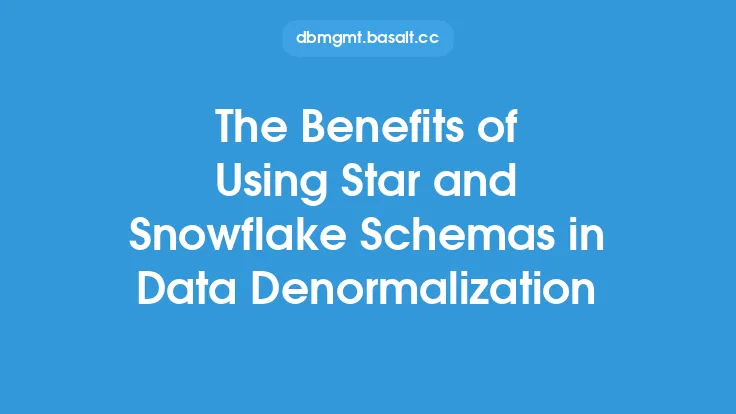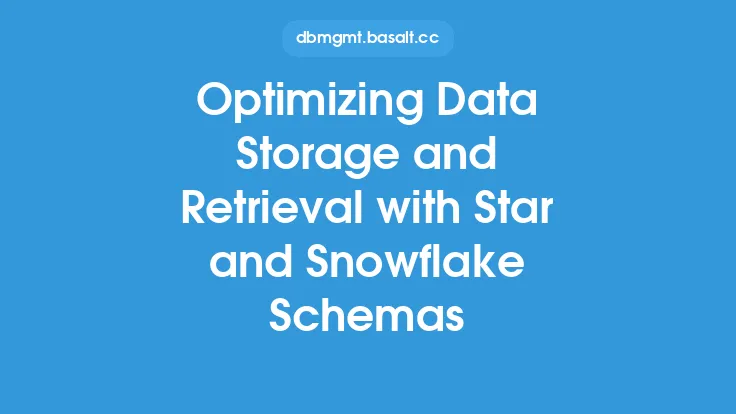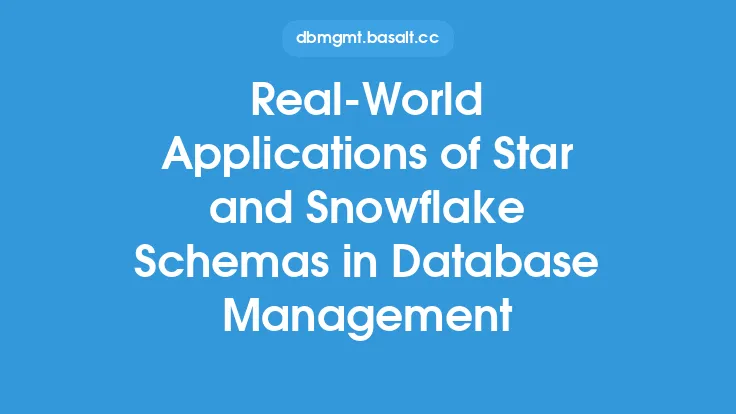When it comes to data denormalization, two popular approaches are star and snowflake schemas. Both methods are used to optimize data storage and retrieval in data warehouses, but they have distinct differences in terms of design, implementation, and performance. In this article, we will delve into the details of star and snowflake schemas, exploring their characteristics, advantages, and disadvantages, to help you choose the right approach for your data denormalization needs.
Introduction to Star Schemas
Star schemas are a type of data warehouse schema that consists of a central fact table surrounded by dimension tables. The fact table contains measurable data, such as sales or website traffic, while the dimension tables provide context to the fact data, such as date, location, or product information. The star schema is called "star" because the dimension tables are connected to the fact table like the points of a star. This design allows for efficient querying and analysis of data, as the fact table can be easily joined to the relevant dimension tables.
Introduction to Snowflake Schemas
Snowflake schemas, on the other hand, are an extension of the star schema. In a snowflake schema, each dimension table is further normalized into multiple related tables, creating a more complex and hierarchical structure. This design is called "snowflake" because the dimension tables are connected to each other like the intricate patterns of a snowflake. Snowflake schemas are useful when there are multiple levels of granularity in the dimension data, such as a product hierarchy with categories, subcategories, and individual products.
Key Differences Between Star and Snowflake Schemas
The main difference between star and snowflake schemas is the level of normalization in the dimension tables. Star schemas have denormalized dimension tables, which means that each dimension table contains all the relevant data for that dimension. In contrast, snowflake schemas have normalized dimension tables, which means that each dimension table is broken down into smaller, more focused tables. This difference in design affects the complexity, performance, and maintainability of the schema.
Advantages and Disadvantages of Star Schemas
Star schemas have several advantages, including improved query performance, simplified data maintenance, and easier data analysis. The denormalized dimension tables allow for faster query execution, as the database does not need to perform complex joins to retrieve the data. Additionally, star schemas are often easier to maintain, as changes to the dimension data only require updates to a single table. However, star schemas can also have disadvantages, such as data redundancy and increased storage requirements. The denormalized dimension tables can lead to data duplication, which can waste storage space and increase the risk of data inconsistencies.
Advantages and Disadvantages of Snowflake Schemas
Snowflake schemas, on the other hand, have advantages such as improved data integrity, reduced data redundancy, and increased flexibility. The normalized dimension tables ensure that each piece of data is stored in one place and one place only, reducing the risk of data inconsistencies and improving data integrity. Additionally, snowflake schemas can handle complex hierarchical data structures, making them ideal for applications with multiple levels of granularity. However, snowflake schemas can also have disadvantages, such as increased complexity, slower query performance, and higher maintenance requirements. The complex joins required to retrieve data from the normalized dimension tables can slow down query execution, and the multiple tables require more maintenance and updates.
Choosing the Right Approach
When choosing between star and snowflake schemas, consider the specific needs of your data warehouse. If you have simple dimension data and prioritize query performance, a star schema may be the better choice. However, if you have complex hierarchical data and prioritize data integrity, a snowflake schema may be more suitable. It's also important to consider the trade-offs between storage requirements, data redundancy, and query performance. Ultimately, the choice between star and snowflake schemas depends on the specific requirements of your data warehouse and the goals of your data analysis.
Best Practices for Implementing Star and Snowflake Schemas
Regardless of which schema you choose, there are several best practices to keep in mind when implementing star and snowflake schemas. First, ensure that your fact table is properly designed, with a clear and consistent grain and relevant measures. Second, use surrogate keys to join the fact table to the dimension tables, rather than relying on natural keys. Third, consider using a data vault or other data modeling technique to handle complex data structures and ensure data consistency. Finally, regularly monitor and maintain your schema, updating it as necessary to reflect changes in your data or business requirements.
Conclusion
In conclusion, star and snowflake schemas are two popular approaches to data denormalization, each with its own strengths and weaknesses. By understanding the characteristics, advantages, and disadvantages of each schema, you can choose the right approach for your data warehouse and optimize your data storage and retrieval. Whether you choose a star schema or a snowflake schema, following best practices and regularly maintaining your schema will ensure that your data warehouse is efficient, scalable, and effective in supporting your business intelligence and data analysis needs.





